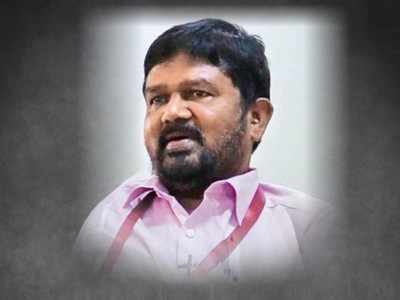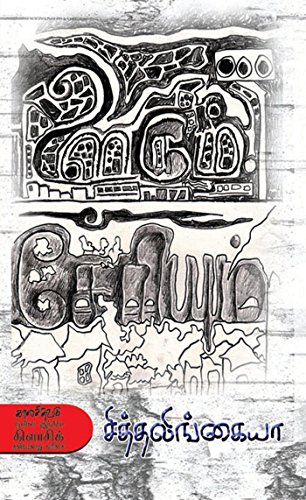
Death of an 'Adikavi' and his influence on Tamil Dalit literature
Before talking about the impact of Siddalingaiah's works in Tamil Nadu, one must know the journey of how this poet emerged as a fiery Dalit Kannada voice in Karnataka during the turbulent times of the state’s history.

My poems speak like somniloquy
This is what Siddalingaiah, the renowned Kannada Dalit poet who died of COVID-19 on June 11, said about his poetic style.
There was however sharp clarity of thought in his poems to be able to raise his voice for ‘his people’ (Nanna Janagalu): the Dalits. He was the voice of the people who died of hunger, those who broke stones for their living, those who were dependent on politicians or other power centres such as farmers, construction workers, weavers, goldmine workers, and “workers who get buried under collapsed buildings” and those the late poet termed as ones who “didn’t see rice and those who don’t have clothes”.
Before talking about the impact of Siddalingaiah’s works in Tamil Nadu, one must know the journey of how this poet emerged as a fiery Dalit Kannada voice in Karnataka during the turbulent times of the state’s history.
Dalit contribution in Kannada literature
The Dalit contribution in Kannada literature started way back in the 12th century during the times of the Vachana writers, said Tamil writer and translator Pavannan, in his preface to the translated poetry collection, Kavignar Siddalingaiah: 40 Kannada Kavithaigal, published in 2014 by Chennai-based Pudhupunal Publications.
“In Devaraj Urs’ regime, Basavalingappa was a minister, who was considered as a leader of the scheduled castes. During a public meeting, he said Kannada literature carries only Hindu views and likened it to cattle fodder. His speech created a major ruckus in the state. The Opposition later turned against the Dalits”, wrote Pavannan.
Also read: Poet Siddalingaiah leaves behind a Dalit movement in disarray
It was also the time when the Act ‘those who plough will get a land’ had been implemented. Because of this Act, many Dalits were gradually coming up in their life. Angered by this, the upper caste people were waiting for a chance to suppress the Dalits again and the opportunity came in the form of Basavalingappa’s speech.
The upper castes formed a group called ‘Kannada Literature Protection’ and this pushed the Dalits to come together as well. In the preface, Pavannan added, “This was how the ‘Dalit Sangarsh Samiti’ was born in 1973. Siddalingaiah was one of the architects of this movement.”

The Bengaluru-based Pavannan, who has translated Siddalingaiah’s autobiography Ooru Keri into Tamil as Oorum Cheriyum in 1996, told The Federal that one of the strengths of the book is that instead of portraying his life as a sorrowful one, Siddalingaiah wrote it in a self-deprecatory manner.
“I think it is hard to clearly establish that Siddalingaiah’s works had a direct impact on the Tamil Dalit literary space. But we can establish a link and continuity since after his autobiography, one of the Dalit writers in Tamil Nadu, the late Prof KA Gunasekaran came out with his autobiography, Vadu (Tamil for scar, published in 2011),” he added.
Siddalingaiah’s poems are usually sung along with the music. These songs were also recorded in audio cassettes and sold in large numbers. However, his poems lack brevity, imagery and symbolisms.
“In a way, Siddalingaiah’s poems can be dubbed as ‘sloganeering poems’. When the poem is sung loudly, it is like a slap on the face of a reader. It was sung in many protests and demonstrations,” said writer and Prof Stalin Rajangam. Siddalingaiah’s poems were anthems for Dalit movements. They were, and are, sung while starting Dalit programmes. Two poems Yarige bantu, ellige bantu nalavattelara swatantrya? and Nanna Jana in fact had attained cult status.
Also read: COVID cuts short poet Siddalingaiah’s struggle against casteism
Influence of Marathi and Kannada Dalit literature
According to Professor Stalin Rajangam, Marathi and Kannada Dalit literature were the pioneers and Tamil Dalit literature followed in their footsteps. “However, more than Marathi, Kannada works have been translated more in Tamil. Writers like Thamizhavan and Pavannan have contributed and done a lot to translate Kannada works and introduce various aspects of Kannada literature,” he said.
Prof Rajangam claimed that Marathi and Kannada Dalit writers were heavily influenced by Ambedkarite movements unlike the Tamil Dalit writers. Hence, when Siddalingaiah’s poems were translated in Tamil, they infused the Tamil Dalit literary space with a new kind of energy.
One of his famous poems found in the collection Nanna Janagalu Mattu Itara Kavitegalu, which is translated in Tamil as En Sananga (My People), would remind a Tamil reader of the late poet Inquilab’s Manusangada, Naanga Manusangada (Humans, we are humans).
K Malarvizhi, translator and a former student of Siddalingaiah said the humble poet knew that his translated poems had created a flutter in the Tamil literary scene. Malarvizhi is a co-translator of the book Kavignar Siddalingaiah: 40 Kannada Kavithaigal along with her friend Madhumitha.
“The collection was well received by the Tamil poets like Sukirtha Rani and lyricists like Vairamuthu and the late Na Muthukumar. The former even went on to write a review about the book. The popular commentator and professor of Kannada in Karnataka, DR Nagaraj terms Siddalingaiah as Adikavi (the first poet) because he was the first poet for Dalits in this century,” she said.


